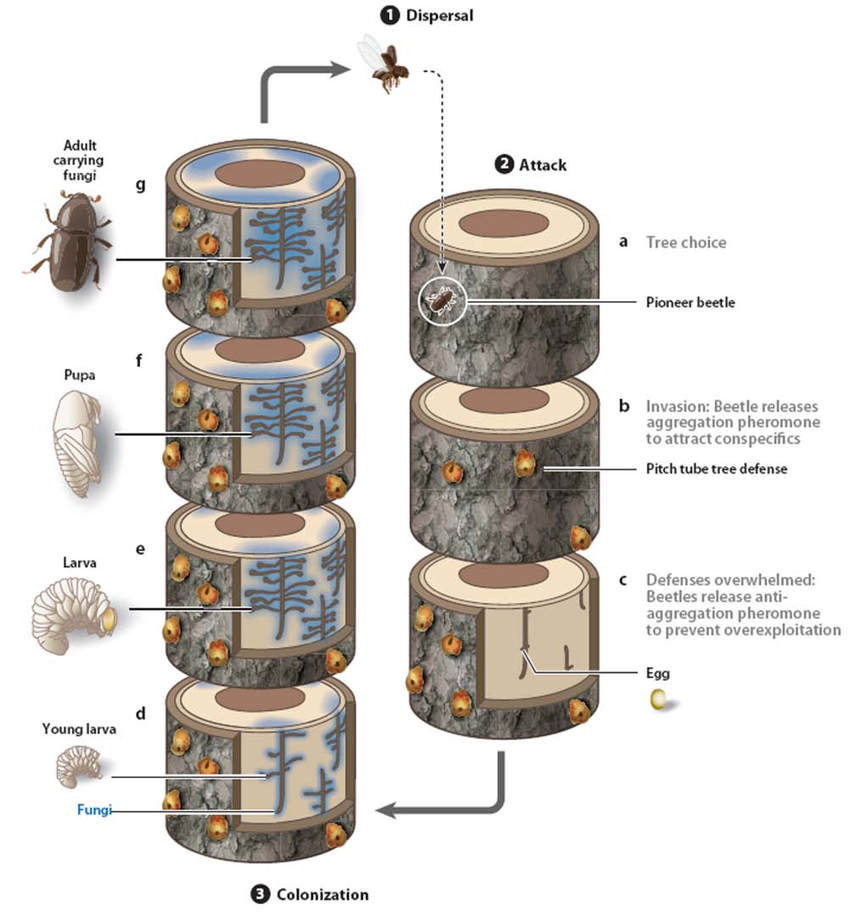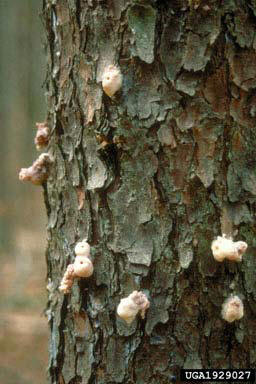Save Your Trees from Pine Bark Beetle and Spruce Beetle with DIY Tree Injection
Pine Bark Beetle and Blue stain Fungus Treatment and Prevention. Take action to protect your pine trees from Pine Bark Beetles with easy “do it yourself” tree injection.
There are a variety of bark beetles that infest conifers throughout North America. Adults beetles travel by flying to a new tree, tunnel through the bark, mate, and lay eggs in the inner bark. The larvae develop, feed on the inner bark causing damage to the tree and emerge by boring out through the bark. Larval feeding cuts grooves along the inner bark and interrupts the tree’s ability to move water and nutrients up and down within the afflicted tree.

Image from – The Role of Phytopathogenicity in Bark Beetle–Fungus Symbioses: A Challenge to the Classic Paradigm, Six, Wingfield, 2011
Several species of beetle also carry spores on their bodies to introduce the blue stain fungus which clogs up the vascular system of the tree and also inhibits the ability of the tree to move water and nutrients. Common species of Pine Bark Beetles include Southern Pine Beetle, Mountain Pine Beetle, Western Pine Beetle, Ips Engraver Beetles, and Spruce Beetles.
Bark beetles are very small, 3-4mm long with cylindrical brown bodies. They are hard see but infestation is easily identifiable by pitch tubes on the tree trunk which are holes in the tree with what appear to be popcorn stuck to them. These are masses of pitch resin which is a symptom of the tree trying to defend itself by producing a lot of pitch where the beetles bore holes through the bark. This defense will work for tree survival from a small number of attacking beetles. But very large numbers of attacking beetles overwhelm this defense. Also drought stressed trees are not able to produce enough of this resin when attacked. Another indication of bark beetle infestation is a significant amount of “sawdust” in bark crevices and on the ground at the base of the tree.
The beetles commonly attack drought-stressed trees. High numbers of boring beetles will result in extensive vascular injury and death of the tree. Trees infested with numerous bark beetles will die, turn brown and needles will fall off.
So, there are two tree mortality threats associated with the pine bark beetles.
- Infestation of the conifer with so many beetles that the larvae girdle the inner bark of the tree, destroying the vascular system and starving the tree of water and nutrients.
- Infection of the conifer with the blue stain fungus which grows within the tree and clogs the vascular system which starves the tree of water and nutrients.
The two afflictions do not always appear together since not all bark beetles will carry the blue stain fungus. There are scenarios where there are not enough bark beetles to infest and kill a tree, but then they carry the blue stain fungus which does kill the tree.
Fortunately there are treatments to protect healthy individual large conifers from both of these afflictions. Tree trunk injection of pesticides can be conducted to make the tree toxic to beetles, and injection of fungicides can be conducted to inhibit growth of the blue stain fungus within the tree. The treatment technologies are described in these studies:
- Evaluations of emamectin benzoate and propiconazole for protecting individual Pinus contorta from mortality attributed to colonization by Dendroctonus ponderosae and associated fungi, Fettig, Munson, Grosman , Bush, Wiley Online Library, 2013
- Impact of Systemic Fungicides on Lesions formed by Inoculation with the Bluestain Fungus in Loblolly Pine, Doccola, Strom, Brownie, Klepzig, ISA, 2011
Chemical Treatment
Pine Bark Beetle Injection Treatment
Direct injection of pesticides through the bark and into the trunk of conifers is an environmentally sound and economical way of treating for Pine Bark Beetles. Trunk injection is a systemic tree treatment which is very efficient and works quickly, with the pesticide circulation throughout the tree within a few days.
This can be easily conducted using Chemjet® Tree Injectors to inject pesticides such as injectable emamectin benzoate (like Tree-age G4 or TreeMec Inject) into small drilled holes at multiple locations around the circumference of the tree. There are specific directions for use of these chemicals on the product labels which should be strictly followed. Using Chemjet Tree injectors, a typical labeled injection rate of Tree-age G4 is 20 ml injected every 6 to 7 inches around the circumference of the trunk.
Following injection, the chemical is then carried by the vascular system throughout the tree, from up to the needles down to the roots, effectively killing or driving away pine bark beetles and larvae currently in the tree, and preventing future infestation by visiting beetles. The Tree-age G4 label indicates that a single injection treatment can protect conifer trees for up to two years before subsequent injection treatment is needed.
Blue Stain Fungus Injection Treatment
The technical articles listed above describe how injection of the fungicide propiconazole was injected into the tree to protect healthy and previously uninfected conifers from the blue stain fungus. Because this is a relatively new treatment breakthrough for conifers, the label for Propiconazole 14.3 does not specifically describe injection treatment for blue stain fungus or conifers. There are descriptions on the product label for tree injection treatment for Oak Wilt and Dutch Elm Disease which are similar tree-killing fungi.
The Doccola et al. study and the label for propiconazole 14.3 describe a systemic tree fungus treatment injection rate of 10 ml per inch diameter at breast height (DBH) for the tree. Chemjet® Tree Injectors would be used to inject this fungicide into small drilled holes at multiple locations around a tree at a rate of 20 ml of a solution of propiconazole 14.3 diluted with an equal volume of water (50/50 mix) injected every 3-inches around the trunk. The chemical is then carried throughout the tree, from up to the branches down to the roots, effectively protecting the tree from harmful infection by the target fungus.
The Doccola et al. study indicates a single injection treatment can protect conifers from blue stain fungus for at least two years before subsequent injection treatment is needed. However fungicide injection will probably not save trees that are already infected with blue stain fungus.
Combined Chemical Injection Treatment
The Fetting et al. study goes on to describe how a mixture of emamectin benzoate and propiconazole was applied to treat lodgepole pines for simultaneous treatment of pine bark beetle and blue stain fungus with good results. This study used a combination of the application rates described above, which are 10 ml Tree-Age per inch DBH plus 10 ml propiconazole 14.3 per inch DBH. Chemjet Tree Injectors could be used at full 20 ml capacity containing a mixture of 10 ml Tree-Age plus 10 ml propiconazole 14.3 at injection interval of 3 to 3.5 inch spacing interval around the tree circumference to accomplish this combined application rate. Please note that this combined chemical injection treatment is experimental as described in the aforementioned technical article. If you are considering trying this treatment you should first confirm the appropriateness of this procedure with a qualified arborist or biologist.
Practical Implementation Considerations
Because of the relative cost and effort involved in conducting systemic tree injections, it is not practical to treat a 100 acre conifer forest. But trunk injection is a way to save a few trees in your yard, woodlot, resort or golf course. You may find arborists and tree care contractors that will come out and conduct these tree injections for you. But you will find the fee they will charge is substantially higher than doing it yourself. And they will likely be using the same chemicals. For resourceful homeowners, farmers or resort groundskeepers, using Chemjet Tree Injectors and the appropriate treatment chemicals in a safe manner is economical and not really that difficult. Here is a video.
There are some regulations that vary state by state regarding use of some pesticides so you should be familiar with these and do all work in a legal manner, including label instructions. The treatment chemicals Tree-age G4 and Propiconazole 14.3 mentioned in this article are not Federal Restricted Use Products at the time of this writing.
It takes a few minutes to a few hours for the chemical to go in the tree. If you have one or two trees to treat you could get by with five Chemjets (re-use them as you drill around the tree). If you have many trees you will need 20 or more Chemjets, which cost about $14 each (prices here: Products)
Note: we are a Distributor for Chemjet Tree Injectors, but do not sell the treatment chemicals. The injectable insecticide Tree-age G4 is quite expensive so check with suppliers on-line for pricing before gearing up to see if it will work with your budget. The injectable fungicide Propiconazole 14.3 is not so costly.
More Information:
Buy Chemjet Tree Injectors Now
Oak Wilt Disease and Treatment
Save your trees from Pine Bark Beetle
Case Study: Microinjection to Protect Trees from Oak Wilt
Hemlock Woolly Adelgid Treatment
Asian Longhorned Beetle Treatment
Plugs for Tree Injection Holes
Video: Chemjet use in Australia




